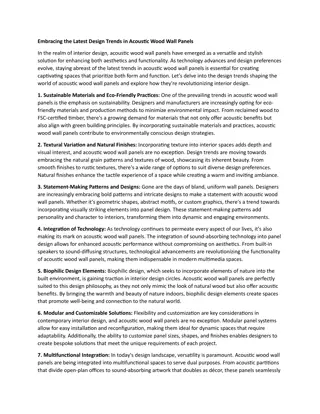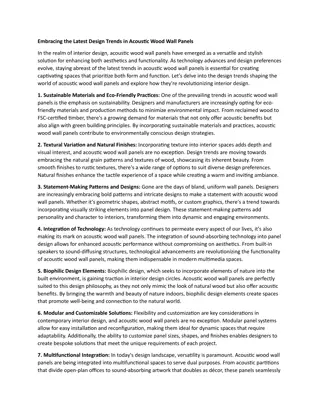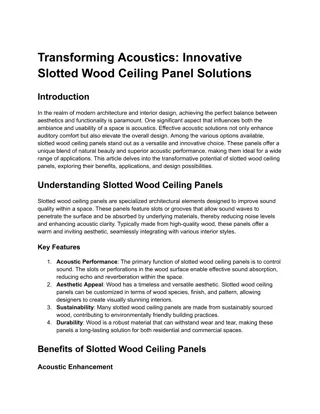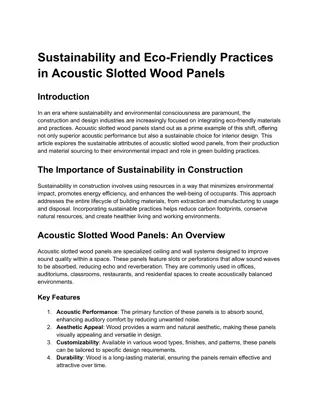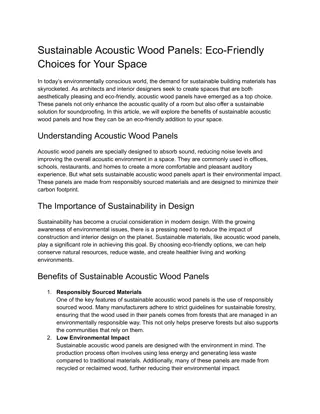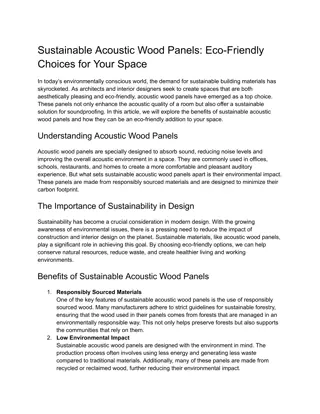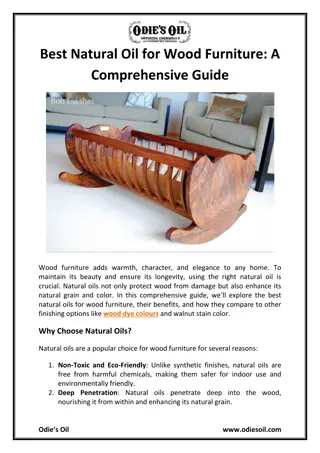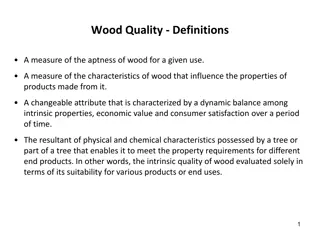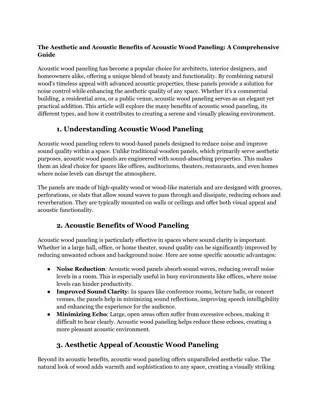
Wood Panels in Australia_ A Comprehensive Guide
Wood panels have long been a staple in the architectural and interior design landscapes of Australia. Their versatility, durability, and natural aesthetic appeal make them a preferred choice for both residential and commercial projects. Whether youu
Download Presentation

Please find below an Image/Link to download the presentation.
The content on the website is provided AS IS for your information and personal use only. It may not be sold, licensed, or shared on other websites without obtaining consent from the author. Download presentation by click this link. If you encounter any issues during the download, it is possible that the publisher has removed the file from their server.
E N D
Presentation Transcript
Wood Panels in Australia: A Comprehensive Guide Wood panels have long been a staple in the architectural and interior design landscapes of Australia. Their versatility, durability, and natural aesthetic appeal make them a preferred choice for both residential and commercial projects. Whether you re looking to enhance the interior of your home or add a touch of elegance to your office space, wood panels offer a timeless solution. This article will explore the different types of wood panels available in Australia, their benefits, popular applications, and tips for choosing the right wood panel for your project. Types of Wood Panels Available in Australia Australia offers a wide range of wood panels, each with unique characteristics and uses. Some of the most popular types include: 1. Solid Wood Panels: Made from a single piece of timber, solid wood panels are known for their strength and durability. Commonly used in flooring, wall cladding, and furniture, they add a natural warmth and richness to any space. Australian hardwoods like Jarrah, Spotted Gum, and Blackbutt are popular choices for solid wood panels due to their resilience and stunning grain patterns. 2. Engineered Wood Panels: Engineered wood panels are composed of multiple layers of wood veneers bonded together. This construction provides superior stability and resistance to warping compared to solid wood. Plywood, MDF (Medium Density Fiberboard), and HDF (High-Density Fiberboard) are common types of engineered wood panels available in Australia. They are often used in cabinetry, shelving, and wall paneling. 3. Veneered Panels: These panels are made by applying a thin layer of high-quality wood veneer over a core material like MDF or particleboard. Veneered panels offer the look of solid wood at a more affordable price point and are commonly used in furniture, cabinetry, and wall coverings. 4. Reclaimed Wood Panels: Reclaimed wood panels are made from repurposed timber, often sourced from old buildings, barns, or factories. These panels are environmentally friendly and add a unique, rustic charm to any space. Reclaimed wood is often used for feature walls, ceilings, and furniture, providing a sense of history and character. 5. Acoustic Wood Panels: Acoustic panels are designed to enhance sound quality in a room by reducing noise and echo. These panels are often perforated or grooved and are used in theaters, recording studios, and office spaces. In Australia, acoustic wood panels are increasingly popular in modern homes where open-plan living spaces require sound management. Benefits of Using Wood Panels in Australia Wood panels offer numerous benefits, making them a popular choice among Australian architects, builders, and homeowners.
1. Aesthetic Appeal: Wood panels add a natural, organic element to any space. The variety of wood species, finishes, and textures available allows for endless design possibilities, from sleek and modern to rustic and traditional. 2. 2Sustainability: Wood is a renewable resource, and many wood panels available in Australia are sourced from sustainably managed forests. Additionally, options like reclaimed wood contribute to environmental conservation by reducing the demand for new timber. 3. 3Durability: High-quality wood panels are built to last. Whether used for flooring, wall cladding, or furniture, wood panels can withstand the test of time, often becoming more beautiful with age. 4. 4Insulation: Wood panels offer natural insulation properties, helping to regulate indoor temperatures and reduce energy consumption. This is particularly beneficial in Australia's diverse climate, where temperatures can vary significantly. 5. Acoustic Properties: Certain wood panels, especially acoustic ones, improve sound quality by absorbing noise and reducing echo. This is crucial in open-plan spaces and areas with high foot traffic. Popular Applications of Wood Panels in Australia Wood panels are incredibly versatile and can be used in various applications throughout homes and commercial spaces in Australia: 1. Wall Cladding: Wood panels are commonly used for interior wall cladding, adding texture, warmth, and character to a room. Feature walls made of wood panels can create a focal point in living rooms, bedrooms, or offices. 2. 2Ceilings: Wood panels can also be used on ceilings to add a touch of luxury and enhance the acoustics of a room. Perforated timber ceilings, for example, are popular in modern Australian homes and commercial spaces. 3. Flooring: Solid wood panels are a classic choice for flooring, offering durability and timeless appeal. Engineered wood panels are also a popular choice for flooring due to their stability and resistance to moisture. 4. 4Furniture: Wood panels are widely used in furniture making, from cabinets and wardrobes to tables and chairs. Veneered panels are particularly popular in furniture design for their aesthetic appeal and cost-effectiveness. 5. Outdoor Use: Certain types of wood panels, like those made from durable Australian hardwoods, are suitable for outdoor use in decking, fencing, and exterior cladding. Tips for Choosing the Right Wood Panels in Australia When selecting wood panels for your project, consider the following factors: 1. Purpose: Determine the primary function of the wood panels whether it's for aesthetic purposes, insulation, or acoustics. This will help you choose the right type of wood panel.
2. Environment: Consider the climate and conditions of the space where the wood panels will be installed. For example, areas with high humidity may require moisture-resistant panels like engineered wood or treated hardwood. 3. Budget: Wood panels vary in price depending on the type, species, and finish. Set a budget and explore options within your price range without compromising on quality. 4. Sustainability: If environmental impact is a concern, look for wood panels that are certified by organizations like the Forest Stewardship Council (FSC) or choose reclaimed wood options. 5. Aesthetic: Consider the overall design and style of your space. Whether you prefer a modern, minimalist look or a more traditional, rustic feel, there s a wood panel option to match your vision. Conclusion Wood panels Australia offer a versatile and sustainable solution for enhancing the beauty and functionality of any space. With a wide range of options available, from solid and engineered wood panels to acoustic and reclaimed varieties, there s a perfect wood panel for every project. By considering factors like purpose, environment, budget, and aesthetics, you can select the ideal wood panel to bring your vision to life. Whether used for wall cladding, flooring, furniture, or ceilings, wood panels provide a timeless elegance that will elevate your space for years to come.

